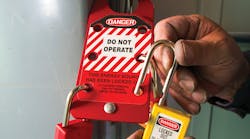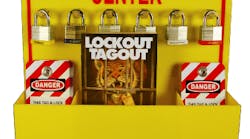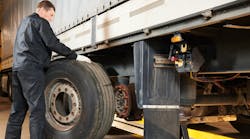The practice of lockout/tagout (LOTO) has been around since the 1980s. The good news is that the number of injuries caused by a lack of sound LOTO procedures has dropped in recent years. The bad news is that LOTO is still No. 5 on OSHA's list of top workplace safety violations. It is critical to point out many people do not realize LOTO also applies to vehicles.
LOTO refers to the procedure of disabling machinery that is undergoing repairs or maintenance. LOTO helps prevent that machinery from accidentally starting or moving, which could seriously injure the technician performing the service. Injuries can range from lacerations and burns to electrocution and crushing. These accidents can also result in death.
The formal OSHA standard is known as The Control of Hazardous Energy (Lockout/Tagout), Title 29 Code of Federal Regulations (CFR) Part 1910.147. Hazardous energy is "stored" energy that could unexpectedly release and start up. Energy sources include electrical, mechanical, hydraulic, pneumatic, chemical and thermal.
LOTO procedures help to control hazardous energy. A designated individual must first turn off and disconnect the machinery from its energy source. Then the individual must either lock or tag the machinery to prevent any accidental startup.
Locking, if the machinery allows, provides the best level of protection. If locking isn't practical, tagging is the next best thing. A tagout device serves as a visible warning to others to not start the machinery.
How LOTO applies to vehicle repair
OSHA first applied the concept of lockout/tagout to the vehicle repair industry in 2008. Directive CPL 02-00-147 added a section on vehicle hazardous energy control to the OSHA standard. The directive points out that any vehicle has the potential to contain a various types of hazardous energy:
- Mechanical hazards associated with unexpected start-up
- Mechanical motions due to moving power transmission components
- Mechanical hazards with disc brake springs and tire components
- Hydraulic hazards associated with fluid pressure and loss
- Gravitational energy from elevated vehicles and lifts
- Gravitational energy from elevated truck-mounted equipment such as dump beds
- Air bag explosion
- Electric battery shock, arc or burns
- Fuel and fluid system fire or explosion
- Hot or cryogenic fluid and surface hazards
- Chemical energy (i.e. battery acid, coolants, lubricants, etc.)
Prior to servicing a vehicle, an obvious initial step is to remove the ignition key from the ignition switch. The technician should maintain sole possession of that key, perhaps placing it in his or her pocket. Doors to the vehicle could also be locked.
However, those two steps are often not enough to prevent an engine from being accidentally started. For instance, an engine could be started if the technician shorts out the ignition circuit. Thus, disconnecting battery cables may also be necessary. Disconnecting batteries is also important when working on or around cooling fans, which can automatically start up after the ignition key has been removed.
It's a good idea to allow an engine to cool down sufficiently. Doing so will allow heat and subsequent pressure to dissipate, helping to control those forms of hazardous energy.
Depending on the type of vehicle being worked on and service being performed, technicians may need to either lower or block-up components that are held up by hydraulic pressure, such as dump beds and aerial lifts. It may also be necessary to chock or block wheels to prevent a vehicle from rolling.
Dump beds can be especially perplexing. Manufacturer-provided props often don't provide the clearance necessary to perform many under-bed repairs. This incites some technicians to create their own support braces, many of which do not provide adequate protection. OSHA says equipment managers should contact the equipment manufacturer to discuss an alternative body prop or other suitable method to perform the work.
Keep in mind that it’s often necessary to re-energize a vehicle or component as part of a testing or troubleshooting process. A procedure should be developed that defines the sequence of actions necessary to accomplish the task safely.
OSHA points out that it is imperative to check with the specific vehicle manufacturer on its service guidelines. Those service guidelines can double as guidelines to help fleets develop energy control procedures in the shop.
Finally, thorough LOTO procedures must be developed for shop equipment including lifts, jacks, tire changers, wheel balancers and pneumatic (compressed air) systems. Again, procedures should be aligned with the equipment manufacturers’ service guidelines.
Tips on implementing a LOTO program
Lockout/tagout is the concern of everyone in a vehicle repair facility—especially the technicians who could be in harm's way. However, it is the employer's responsibility to develop, document, implement and enforce energy control procedures.
An employer does have the flexibility to tailor the program to his or her unique workplace. That said, there are certain OSHA requirements that must be followed.
Use lockout devices whenever possible to hold an energy-isolating device in a safe position. An energy-isolating device is a mechanical device that prevents the release of energy. Examples include circuit breakers, disconnect switches, line valves and safety blocks. Lockout can be used when the energy-isolating device has a locking mechanism built into it, or has a hasp or other part to which a lock can be attached.
Only use tagout devices when lockout is improbable. That said, an employer could choose to implement a tagout procedure provided that full employee protection will be provided. This includes attaching a tag at the same location a lock would be attached. Furthermore, one additional safety measure must be used. Examples include fuse removal, closure of a second in-line valve, and locking or blocking a control switch.
Lockout is not only considered the best measure, but it is perhaps the easiest and most sensible to execute if given the choice.
Other OSHA requirements for energy control procedures include:
- Only use LOTO devices that are authorized for the particular machinery
- Only use LOTO devices that are durable and standardized
- Make sure LOTO devices identify the individual users
- Establish a policy that permits only the employee who applied the LOTO device to remove it
- Inspect energy control procedures at least annually
- Provide thorough training to all necessary employees.
"The essential components of a lockout/tagout program are written procedures, employee training and annual inspection of your procedures," says Judie Smithers, J.J. Keller’s workplace safety editor. "It's very important to make sure your training documentation remains up–to-date. OSHA wants a simple certification document that includes the names of the employee and trainer."
J.J. Keller & Associates (jjkeller.com) is a source for workplace safety, transportation, construction and human resources products and services.
It is essential that the training program help to ensure that employees understand all applicable energy sources, methods of isolating and/or controlling those energy sources, and methods to verify effective energy control.
"Employee retraining may be necessary from time to time," Smithers points out.
Examples are when a fleet identifies deficiencies in existing procedures and makes a change, or when technicians take on new tasks or begin working on new machinery, as would be the case if a new vehicle type were added to a fleet or brought in to be serviced.
Procedural deficiencies are normally identified during annual inspection.
"You have to visually observe an employee performing the lockout/tagout procedures," Smithers explains. "Then you discuss the findings with all employees who would be following that procedure."
Get it in writing
As is the case with most rules and regulations, there are provisions with respect to OSHA's hazardous energy control standard. Other things fleets may need to consider are shift/personnel changes and the use of outside contractors. A workplace is a unique environment, so an energy control program will be unique to each company’s operations.
It is important for a company's procedures to be in writing. It is also important to note there should be several procedures documented. Individual procedures should be developed for each type of "job" a technician might do. This could result in several written LOTO procedures for a single vehicle or piece of equipment.
Minimum elements of a written energy control procedure include:
- A specific statement of the intended use of the procedures
- Specific steps for shutting down, isolating, blocking and securing vehicles and equipment
- Specific steps for the placement, removal and transfer of LOTO devices
- Specific requirements for testing a vehicle or piece of equipment to verify the effectiveness of LOTO devices and other control measures.
OSHA says a written procedure doesn't need to be overly complicated. It just needs to be specific and thorough. OSHA offers various publications and tools to help managers develop a sound LOTO program for their organization, including free on-site consultations.
On that note, an insurance company may also be willing to send a representative out to help assess hazards in your shop. Additionally, organizations such as J.J. Keller provide consultative services.
In other words, fleets have help if needed. When it comes to something as important as lockout/tagout, do not be afraid to ask.



